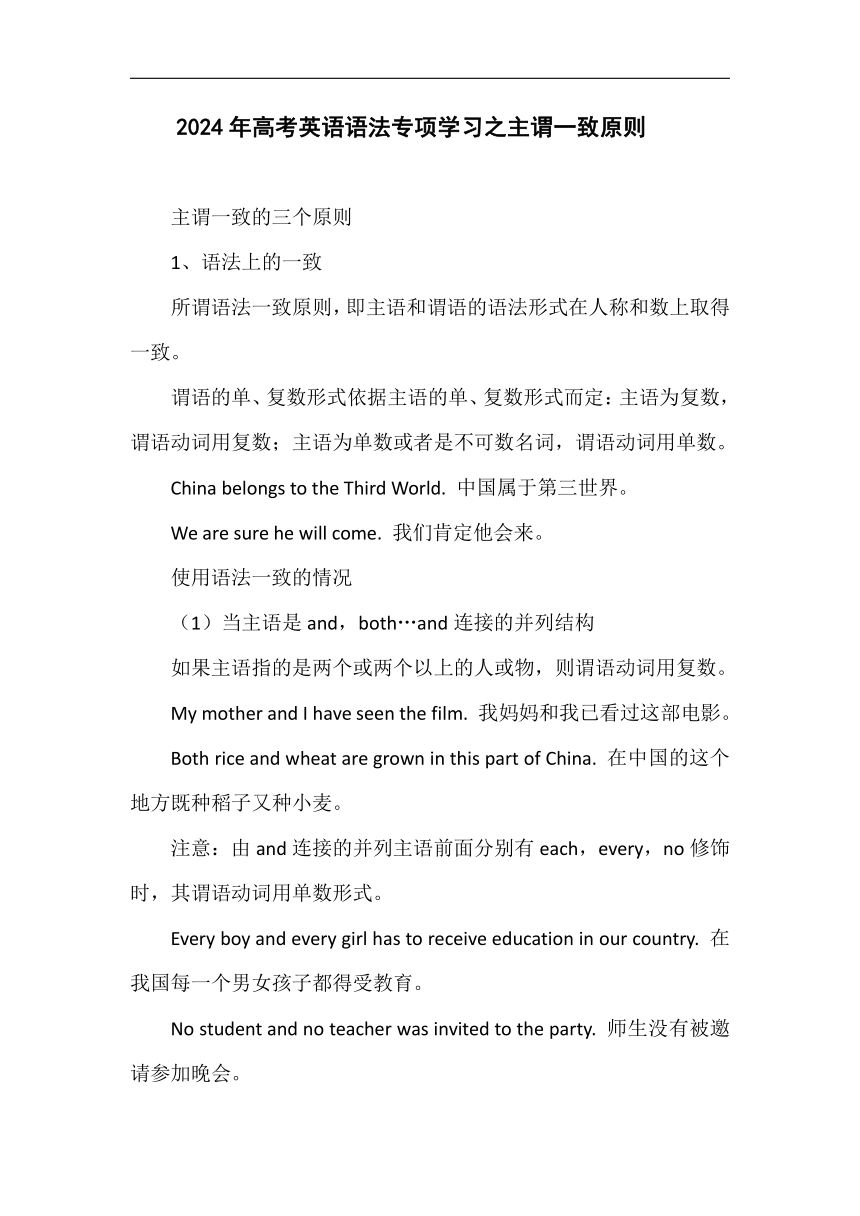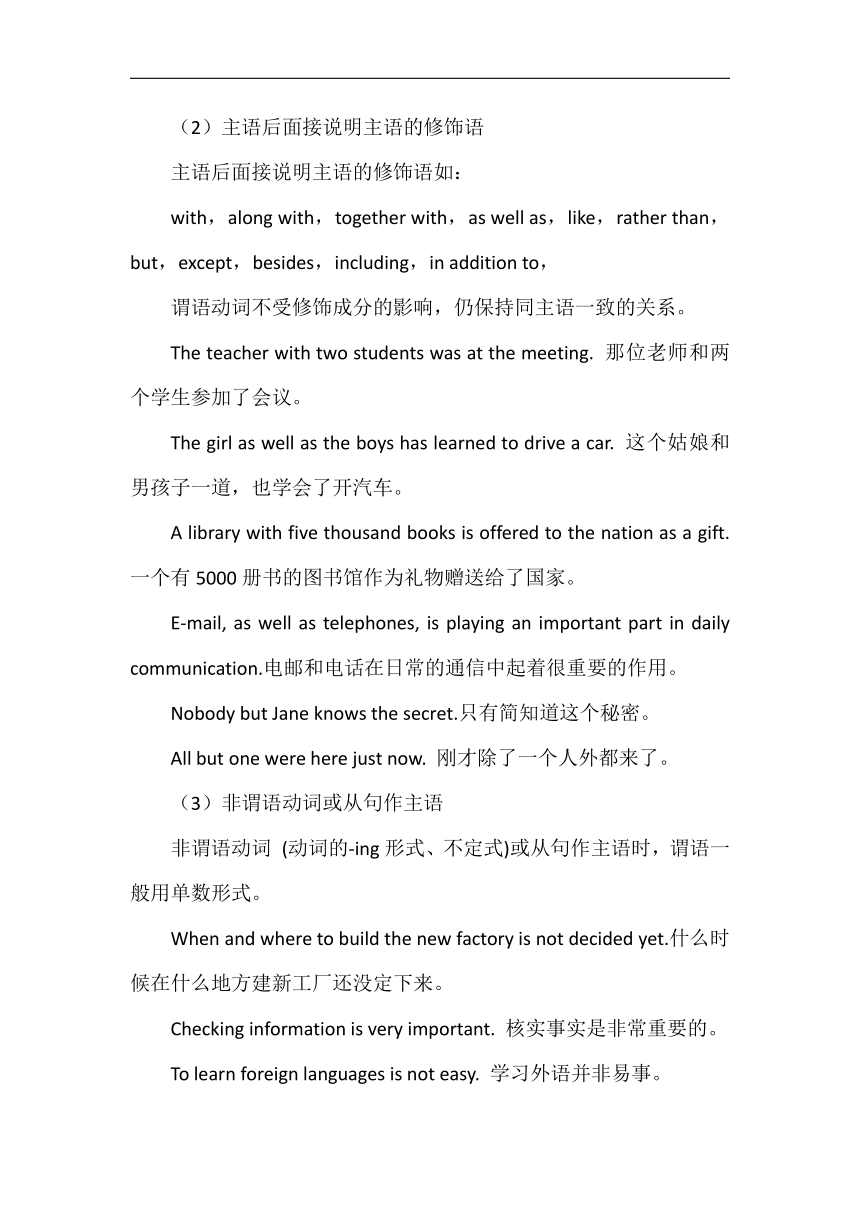2024届高考英语语法专项学习之主谓一致原则讲义
文档属性
| 名称 | 2024届高考英语语法专项学习之主谓一致原则讲义 |

|
|
| 格式 | docx | ||
| 文件大小 | 19.8KB | ||
| 资源类型 | 教案 | ||
| 版本资源 | 通用版 | ||
| 科目 | 英语 | ||
| 更新时间 | 2024-04-13 21:00:49 | ||
图片预览




文档简介
2024年高考英语语法专项学习之主谓一致原则
主谓一致的三个原则
1、语法上的一致
所谓语法一致原则,即主语和谓语的语法形式在人称和数上取得一致。
谓语的单、复数形式依据主语的单、复数形式而定:主语为复数,谓语动词用复数;主语为单数或者是不可数名词,谓语动词用单数。
China belongs to the Third World. 中国属于第三世界。
We are sure he will come. 我们肯定他会来。
使用语法一致的情况
(1)当主语是and,both…and连接的并列结构
如果主语指的是两个或两个以上的人或物,则谓语动词用复数。
My mother and I have seen the film. 我妈妈和我已看过这部电影。
Both rice and wheat are grown in this part of China. 在中国的这个地方既种稻子又种小麦。
注意:由and连接的并列主语前面分别有each,every,no修饰时,其谓语动词用单数形式。
Every boy and every girl has to receive education in our country. 在我国每一个男女孩子都得受教育。
No student and no teacher was invited to the party. 师生没有被邀请参加晚会。
(2)主语后面接说明主语的修饰语
主语后面接说明主语的修饰语如:
with,along with,together with,as well as,like,rather than,but,except,besides,including,in addition to,
谓语动词不受修饰成分的影响,仍保持同主语一致的关系。
The teacher with two students was at the meeting. 那位老师和两个学生参加了会议。
The girl as well as the boys has learned to drive a car. 这个姑娘和男孩子一道,也学会了开汽车。
A library with five thousand books is offered to the nation as a gift.一个有5000册书的图书馆作为礼物赠送给了国家。
E-mail, as well as telephones, is playing an important part in daily communication.电邮和电话在日常的通信中起着很重要的作用。
Nobody but Jane knows the secret.只有简知道这个秘密。
All but one were here just now. 刚才除了一个人外都来了。
(3)非谓语动词或从句作主语
非谓语动词 (动词的-ing形式、不定式)或从句作主语时,谓语一般用单数形式。
When and where to build the new factory is not decided yet.什么时候在什么地方建新工厂还没定下来。
Checking information is very important. 核实事实是非常重要的。
To learn foreign languages is not easy. 学习外语并非易事。
When we will hold the meeting is not decided yet. 我们何时开会尚未决定。
注意:当what引导主语从句或由 and连接两个动词不定式或动名词作主语时,谓语动词的数应根据意义一致的原则来决定。
What we need here is money.我们这里需要的是资金。
What we need here are workers.我们这里需要的是工人。
Lying and stealing are immoral.说谎与偷窃是不道德的。
(4)each和复合不定代词作主语
each和some/any/no//every十body/one/thing构成的复合不定代词:
anyone、anybody、anything、everyone、everybody、everything、someone、somebody、something、no one、nobody、nothing、each、the other作主语,谓语动词用单数。
Each is worse than the one before. 一个比一个差。
Nobody knows the answer. 没有一个人知道这答案。
Someone wants to see you. 有人想见你。
Is there anything in the box 箱子里有什么东西吗
There is a lot of milk in the bottle. 瓶子里有很多奶。
(5)“many a +单数名词”作主语
“many a、(很多)/more than one(不只一个)+单数名词”作主语时,谓语动词用单数形式。
Many a student has been to Beijing. 很多学生去过北京。
There is more than one answer to your question. 你的问题不只有一个答案。
(6)“one of+复数名词十定语从句”之前有the等限定词和修饰语
“one of+复数名词十定语从句”之前有the only,the very,the等限定词和修饰语时,定语从句的谓语动词用单数形式。
Tom is the only one of those boys who is willing to help the old man.
汤姆是唯一的一个愿意帮助那个老人的男孩。
He is the only one of the students who has been a winner of scholarship for three years.他是这三年来唯一的一个获得奖学金的学生。
注意:如没有这些限定词和修饰语,定语从句的谓语动词采用复数形式。
Tom is one of the boys who are always ready to help others. 汤姆是个随时愿意帮助别人的男孩。
(7)由两个部分组成的物体名词作主语
英语中有些由两个部分组成的物体名称如g1asses(眼镜),scissors(剪刀),shorts(短裤),shoes(鞋子),trousers(裤子)等作主语,其后的谓语动词用复数形式。
His glasses were broken, so he can't see well. 他的眼镜碎了,因而看不清楚。
His trousers are made of cotton. 他的裤子是棉布的。
注意:若这类名词前带有pair等表示单位的名词时,则以这些名词的单、复数形式决定动词的形式。
Two pairs of trousers are missing. 两条裤子不见了。
This pair of shoes is not on sale. 这双鞋不出售。
2、意义上的一致
意义上的一致是指谓语动词与主语的一致取决于主语所表达的意义。若主语形式上为复数,而意义上是单数,动词要用单数;
若主语形式上为单数,而意义上为复数,则动词用复数。
The United States is in North America. 美国在北美洲。
The police are looking into the matter. 警察正在调查此事。
主谓一致中的"表里不一"现象
和主语必须在人称和数上保持一致,最基本的原则是:单数主语用单数动词,复数主语用复数动词.但在实际使用当中情况比较复杂,现在学生常犯的主谓一致错误归纳整理如下
1,"more than one +名词"作主语时,谓语动词常用单数.例如:
More than one teacher gets the flowers. 不止一个教师得到了花.
2,"many a +名词"作主语时,从意义上看是复数,但谓语动词常用单数.例如:
Many a student has been sent to plant trees. 很多学生被派去植树.
3,"half of,the rest of,most of,all of及百分数或分数+of 等后接名词"作主语时,谓语动词形式根据of后的名词而定.例如:
Three fourths of the surface of the earth is covered with water.地球表面四分之三为水所覆盖.
4,all指人时,动词用复数;all指物时,动词用单数.例如:
"All are present and all is going well." 所有人全部到场了,一切进展顺利
5,what引导的主语从句,谓语动词可视表语而定:表语是单数名词时,动词用单数,相反,则用复数.例如:
What they want to get are a number of good books.他们想得到的是大量的好书.
6,and连接的两个单数名词前若用each,every,no修饰,该名词短语作主语时,谓语动词用单数形式.例如:
No book and no pen is found in the schoolbag.书包里没有书和钢笔.
7,当主语后面有as well as,with,along with,together with,but,like,rather than,except,逗号加and连接几个名字等引导的短语时,谓语动词要与最前面的主语保持一致.例如:
My father as well as his workmates has been to Beijing. 我父亲和他的同事曾去过北京.
8,each作主语的同位语时,谓语动词由主语来决定,与each无关.例如:
They each have a bike. 他们每人有一辆自行车.
9,动词不定式,动词-ing形式短语作主语时,谓语动词常用单数.例如:
Going out for a walk after supper is a good habit.晚饭后出去散步是一个好习惯.
10,the following作主语时,谓语动词的数与后面名词的数保持一致.例如:
The following are good examples下面是一些好例子.
11,以-ics结尾的学科名词,如politics,physics,mathematics等作主语时,谓语动词用单数.以-s结尾的名词news,works,plastics等同属此类.例如:
Politics is now taught in all schools. 现在各学校都开设政治课.
当以-ics结尾的学科名词表示"学科"以外的意义时,用作复数,如:mathematics(运算能力)politics(政治观点)economics(经济意义)等
12,有些用来表示由两个对应部分组成一体的名词复数(trousers,glasses,shoes.shorts.scissors.scales等)作主语时,前面若有"一条","一副","一把"之类的单位词,动词用单数;若没有单位词或单位词是复数,则谓语动词用复数.例如:
The shoes are all right. 这些鞋子都很合适.
还有一些以-s结尾的名词通常用复数:arms(武器).clothes.contents.minites(记录).remains(遗体).thanks等
13,"one and a half +名词"作主语时,谓语动词要用复数.例如:
One and a half apples are left on the table. 桌子上有一个半苹果.
14,"One or two more +复数名词"作主语时,谓语动词用复数.例如:
One or two persons are sent there to help them do the work. 要派一两个人到那儿去给他们帮忙.
15,"one of+复数名词+ 定语从句"结构中,定语从句的谓语动词要用复数;而在"the only one of +复数名词+定语从句"的结构中,"the one of + 复数名词+定语从句"定语从句的谓语动词要用单数.例如:
He is one of the students who get there on time.他是准时到达那里的学生之一.
16,表示时间,距离,金钱等的复数名词作主语表达一个整体概念时,谓语动词常用单数,但若强调数量,谓语动词可用复数.例如:
One million dollars is a lot of money. 一百万美元是一大笔钱.
主谓一致的三个原则
1、语法上的一致
所谓语法一致原则,即主语和谓语的语法形式在人称和数上取得一致。
谓语的单、复数形式依据主语的单、复数形式而定:主语为复数,谓语动词用复数;主语为单数或者是不可数名词,谓语动词用单数。
China belongs to the Third World. 中国属于第三世界。
We are sure he will come. 我们肯定他会来。
使用语法一致的情况
(1)当主语是and,both…and连接的并列结构
如果主语指的是两个或两个以上的人或物,则谓语动词用复数。
My mother and I have seen the film. 我妈妈和我已看过这部电影。
Both rice and wheat are grown in this part of China. 在中国的这个地方既种稻子又种小麦。
注意:由and连接的并列主语前面分别有each,every,no修饰时,其谓语动词用单数形式。
Every boy and every girl has to receive education in our country. 在我国每一个男女孩子都得受教育。
No student and no teacher was invited to the party. 师生没有被邀请参加晚会。
(2)主语后面接说明主语的修饰语
主语后面接说明主语的修饰语如:
with,along with,together with,as well as,like,rather than,but,except,besides,including,in addition to,
谓语动词不受修饰成分的影响,仍保持同主语一致的关系。
The teacher with two students was at the meeting. 那位老师和两个学生参加了会议。
The girl as well as the boys has learned to drive a car. 这个姑娘和男孩子一道,也学会了开汽车。
A library with five thousand books is offered to the nation as a gift.一个有5000册书的图书馆作为礼物赠送给了国家。
E-mail, as well as telephones, is playing an important part in daily communication.电邮和电话在日常的通信中起着很重要的作用。
Nobody but Jane knows the secret.只有简知道这个秘密。
All but one were here just now. 刚才除了一个人外都来了。
(3)非谓语动词或从句作主语
非谓语动词 (动词的-ing形式、不定式)或从句作主语时,谓语一般用单数形式。
When and where to build the new factory is not decided yet.什么时候在什么地方建新工厂还没定下来。
Checking information is very important. 核实事实是非常重要的。
To learn foreign languages is not easy. 学习外语并非易事。
When we will hold the meeting is not decided yet. 我们何时开会尚未决定。
注意:当what引导主语从句或由 and连接两个动词不定式或动名词作主语时,谓语动词的数应根据意义一致的原则来决定。
What we need here is money.我们这里需要的是资金。
What we need here are workers.我们这里需要的是工人。
Lying and stealing are immoral.说谎与偷窃是不道德的。
(4)each和复合不定代词作主语
each和some/any/no//every十body/one/thing构成的复合不定代词:
anyone、anybody、anything、everyone、everybody、everything、someone、somebody、something、no one、nobody、nothing、each、the other作主语,谓语动词用单数。
Each is worse than the one before. 一个比一个差。
Nobody knows the answer. 没有一个人知道这答案。
Someone wants to see you. 有人想见你。
Is there anything in the box 箱子里有什么东西吗
There is a lot of milk in the bottle. 瓶子里有很多奶。
(5)“many a +单数名词”作主语
“many a、(很多)/more than one(不只一个)+单数名词”作主语时,谓语动词用单数形式。
Many a student has been to Beijing. 很多学生去过北京。
There is more than one answer to your question. 你的问题不只有一个答案。
(6)“one of+复数名词十定语从句”之前有the等限定词和修饰语
“one of+复数名词十定语从句”之前有the only,the very,the等限定词和修饰语时,定语从句的谓语动词用单数形式。
Tom is the only one of those boys who is willing to help the old man.
汤姆是唯一的一个愿意帮助那个老人的男孩。
He is the only one of the students who has been a winner of scholarship for three years.他是这三年来唯一的一个获得奖学金的学生。
注意:如没有这些限定词和修饰语,定语从句的谓语动词采用复数形式。
Tom is one of the boys who are always ready to help others. 汤姆是个随时愿意帮助别人的男孩。
(7)由两个部分组成的物体名词作主语
英语中有些由两个部分组成的物体名称如g1asses(眼镜),scissors(剪刀),shorts(短裤),shoes(鞋子),trousers(裤子)等作主语,其后的谓语动词用复数形式。
His glasses were broken, so he can't see well. 他的眼镜碎了,因而看不清楚。
His trousers are made of cotton. 他的裤子是棉布的。
注意:若这类名词前带有pair等表示单位的名词时,则以这些名词的单、复数形式决定动词的形式。
Two pairs of trousers are missing. 两条裤子不见了。
This pair of shoes is not on sale. 这双鞋不出售。
2、意义上的一致
意义上的一致是指谓语动词与主语的一致取决于主语所表达的意义。若主语形式上为复数,而意义上是单数,动词要用单数;
若主语形式上为单数,而意义上为复数,则动词用复数。
The United States is in North America. 美国在北美洲。
The police are looking into the matter. 警察正在调查此事。
主谓一致中的"表里不一"现象
和主语必须在人称和数上保持一致,最基本的原则是:单数主语用单数动词,复数主语用复数动词.但在实际使用当中情况比较复杂,现在学生常犯的主谓一致错误归纳整理如下
1,"more than one +名词"作主语时,谓语动词常用单数.例如:
More than one teacher gets the flowers. 不止一个教师得到了花.
2,"many a +名词"作主语时,从意义上看是复数,但谓语动词常用单数.例如:
Many a student has been sent to plant trees. 很多学生被派去植树.
3,"half of,the rest of,most of,all of及百分数或分数+of 等后接名词"作主语时,谓语动词形式根据of后的名词而定.例如:
Three fourths of the surface of the earth is covered with water.地球表面四分之三为水所覆盖.
4,all指人时,动词用复数;all指物时,动词用单数.例如:
"All are present and all is going well." 所有人全部到场了,一切进展顺利
5,what引导的主语从句,谓语动词可视表语而定:表语是单数名词时,动词用单数,相反,则用复数.例如:
What they want to get are a number of good books.他们想得到的是大量的好书.
6,and连接的两个单数名词前若用each,every,no修饰,该名词短语作主语时,谓语动词用单数形式.例如:
No book and no pen is found in the schoolbag.书包里没有书和钢笔.
7,当主语后面有as well as,with,along with,together with,but,like,rather than,except,逗号加and连接几个名字等引导的短语时,谓语动词要与最前面的主语保持一致.例如:
My father as well as his workmates has been to Beijing. 我父亲和他的同事曾去过北京.
8,each作主语的同位语时,谓语动词由主语来决定,与each无关.例如:
They each have a bike. 他们每人有一辆自行车.
9,动词不定式,动词-ing形式短语作主语时,谓语动词常用单数.例如:
Going out for a walk after supper is a good habit.晚饭后出去散步是一个好习惯.
10,the following作主语时,谓语动词的数与后面名词的数保持一致.例如:
The following are good examples下面是一些好例子.
11,以-ics结尾的学科名词,如politics,physics,mathematics等作主语时,谓语动词用单数.以-s结尾的名词news,works,plastics等同属此类.例如:
Politics is now taught in all schools. 现在各学校都开设政治课.
当以-ics结尾的学科名词表示"学科"以外的意义时,用作复数,如:mathematics(运算能力)politics(政治观点)economics(经济意义)等
12,有些用来表示由两个对应部分组成一体的名词复数(trousers,glasses,shoes.shorts.scissors.scales等)作主语时,前面若有"一条","一副","一把"之类的单位词,动词用单数;若没有单位词或单位词是复数,则谓语动词用复数.例如:
The shoes are all right. 这些鞋子都很合适.
还有一些以-s结尾的名词通常用复数:arms(武器).clothes.contents.minites(记录).remains(遗体).thanks等
13,"one and a half +名词"作主语时,谓语动词要用复数.例如:
One and a half apples are left on the table. 桌子上有一个半苹果.
14,"One or two more +复数名词"作主语时,谓语动词用复数.例如:
One or two persons are sent there to help them do the work. 要派一两个人到那儿去给他们帮忙.
15,"one of+复数名词+ 定语从句"结构中,定语从句的谓语动词要用复数;而在"the only one of +复数名词+定语从句"的结构中,"the one of + 复数名词+定语从句"定语从句的谓语动词要用单数.例如:
He is one of the students who get there on time.他是准时到达那里的学生之一.
16,表示时间,距离,金钱等的复数名词作主语表达一个整体概念时,谓语动词常用单数,但若强调数量,谓语动词可用复数.例如:
One million dollars is a lot of money. 一百万美元是一大笔钱.
